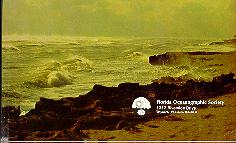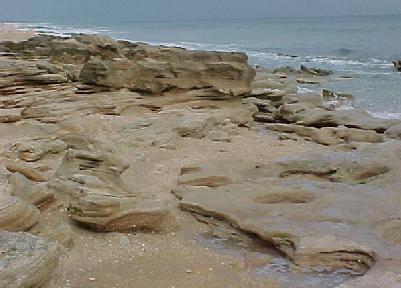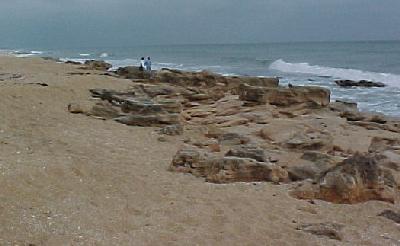 ROCKY
SHORES
ROCKY
SHORES 
The rocky intertidal habitat has a very rich diversity of organisms especially in temperate climates. Attachment is critical and competition for space is a prime factor. The organisms are well adapted for withstanding tremendous SURF-EXPOSURE. Also tolerance to DESICCATION (low tides during the summer days), temperature changes, and salinity changes( rainfall during low tide).
When the tide goes
out, the phenomenon of ZONATION is manifested - horizontal bands or zones of
organisms. This is true for both plants and animals. Each zone has a particular
color or texture from the organisms inhabiting that particular zone. UNIVERSAL
PATTERNS of zonation, occurring throughout the world, have been recognized,
such that no matter where you might be observing the exposed intertidal, the
middle littoral zone will often have a community of barnacles, mussels, and
rockweeds.
The nature of the rock between the tide marks may exert a certain selective influence on the organisms that attempt to colonize it, in the sense that some rocks are more susceptible to the activities of boring organisms and others are not and certain minor variations in zonation may also be attributed to it. Rocks between the tidemarks include GRANITE, HARD QUARTZITIC SANDSTONES, SOFT SANDSTONES (calcareous or not), DOLERITE, CONGLOMERATES, LIMESTONES, SLATELIKE ROCKS, and various other materials. You see, porous sandstone will hold water longer during low tide than granite and other non-porous rocks and therefore may exhibit a different type of zonation than other rocks nearby. Rock texture/rough and smooth does not really seem to have much of an effect unless friability is considered where pieces of rock (bearing attached organisms) may break off.
The proximity of sand also affects populations of adjacent rocky areas. In some cases, sands shift a good deal, so that a low rocky reef may be buried under sand at one, and emerged at another time. This does not always kill everything on the reef unless it lasts for a long time.
Desiccation / drying out plays a role in organisms to the degree which they can withstand exposure to the air between the tidemarks. I may affect organisms in two ways: it may be intense, but for short duration, or less severe, but of repeated occurrence. It can be intensified by increased temperature and air movement (and light).
Factors controlling
the distribution of organisms on the PACIFIC coast: Predation is #1; also
competition, exposure to the waves, desiccation, and rain water. On the
East coast intertidal
populations are affected dramatically by the relatively LARGE SEASONAL
TEMPERATURE CHANGES: Predation is also important but less so than in the
Pacific.
The Upper intertidal zone: usually termed the LITTORINA ZONE, named after the small herbivorous gastropods (periwinkles) that occupy this zone that must survive long periods of exposure. This zone extends higher than the highest tide where there is great exposure with spray from the various waves causing the organisms to extend higher into the littoral zone.
There may be several species of these snails but each species occupy their specific niche..species 1 are the most tolerant and occupy the highest level, species 2, less tolerant and occupy the next and so on. (one lower species mimics the air bladders of rockweed). There is even a higher zone than the periwinkles and it is occupied by LICHENS (Verrucaria) which occupy a dark zone above the periwinkles and/or blue-green algae (covered with mucilage to prevent total desiccation.
Middle intertidal zone: barnacles (upper part), rockweed (middle), & mussels (lower) occupy this zone and each will have one distinct advantage in regard to their area over the others. Mussels and seaweeds can crowd out the barnacles but the barnacles can tolerate surf and desiccation better, giving them the upper position in the Mid-littoral.
Barnacle life cycle
- eggs hatch into napulus larva
- molts 6 times and turns into cypris larva
- cypris larva finds place to attach
- secretes cement from cement glands on the 1st antennae to attach
- develop into adult
The rockweeds in the middle of the mid-littoral zone provide a nice moist protective canopy when the tide is out, so many inverts. can survive underneath. The green crab hides under it during the day and comes out at night.
Below the rockweed are beds of mussels (Mytilis) using their byssal threads to attach. Their shape allows them to adapt well to the wave force and adductor muscles tightly hold them closed at low tide...protecting them from predators and desiccation. Mussels release sperm and eggs into the water, (external fertilization) and environmental cues affect members of the population to bring about a synchronous release of gametes, resulting in maximum opportunity for successful fertilization. The eggs turn into a VELIGER larva which exists as plankton until it finally settles down and crawls around looking for a favorable site (strongest currents to bring lots of food). Mussels will be preyed on by certain snails, seastars, crabs, shorebirds, lobsters etc. but while the mussels are uncovered for a while, the marine organisms can only get them while they are covered (and birds vice versa) Tough life!
FORAGING RUNS...the Predation above, which opens up the habitat for other species and thus increases species diversity. The greater the diversity, the more links in the food chain of that community.
LOWER INTERTIDAL ZONE
There is less time of exposure to air as you get lower into the zone. These organisms while less tolerant of air are better adapted to wave exposure. Dense strands of kelp can occur here and all this provides living and hiding spaces for a variety of inverts. (hydroids, bryozoans, nudibranches, worms, crabs, tunicates. Some are more conspicuous like the sea anemones, sea urchins, and sea stars.
Some anemones have algae living with them but all capture food, sea urchins graze on the algae in this zone which increases species diversity. Exceptions are that often only one or two species of algae grow when the urchins are very active but then control of urchins by sea otters and sea birds, lobster and fish all return things to normal.
A filter feeding gastropod, the slipper shell (Crepidula), filter feeds and can change sex. They grip the substrate tightly with their foot and filter feed and can fertilize the females below them and eventually transform into females. If the area is lacking females, they will stay longer as males.
Some inverts. can BURROW or BORE into hard substrates: rock, coral, wood by either mechanical abrasion or chemical dissolution. Some mussels, date mussels, secrete acid and dissolve limestone, gribbles are small wood-boring isopods that simply chew into wood. Teredo (shipworm) are also filter feeders as well as eat wood.
Tide pools are
depressions of varying size in the intertidal such as when the tide is out, standing
water is left behind like an oasis for algae and animals. They are subjected to
great fluctuations in regard to temp. salinity, acidity, dissolved oxygen
content... The higher the pool is in the littoral zone, the longer the pool
will be exposed, or isolated from the flush of the oceans waves. Depth in the
pool is important, as is the overall size. If then tide is out at night, the
release of CO2 from the respiring animals and plants will increase (NO Ps) and
increase the acidity of the pool. During the day, PS will cause the pH to
increase. The larger pools in the mid zones allow the inverts, seastars etc. to
live higher up on the rocks and therefore be able to feed in the upper areas
longer. In






Rocky Beaches of
Biological succession: going from bare rock to a mature, or climax community, although nothing is permanent. Predation brings about open areas or physical abrasion by logs often destroy communities in the intertidal. The term conditioning is used to refer to the process by which a bare rock surface must go through a sequence of first being settled by bacteria and algae and such slime-producing organisms before the larva of barnacles and zygotes of rockweeds will be able to attach themselves. Then mussel larva will settle down and crowd out the barnacles and rockweeds restricting them to higher areas. Predators and mussels will next move into the picture.
Trophic structure on the rocky beach community: Primary production is the Ps activity of the BENTHIC seaweeds and also a good part from the phytoplankton being washed over the area whenever the tide is in. Also dissolved organic matter and detritus will be a source of nourishment for filter feeding/suspension feeders/sponges, barnacles, mussels, while the grazers, chitons, periwinkles, limpets, sea urchins are scraping off the benthic flora. Tidal fluctuations make for a good contribution coming from outside the narrow confines of the littoral zone and this results in a large biomass or carrying capacity and the numerous predators at various levels that enter this ecosystem and the rich diversity of species and high density of individuals inhabiting the intertidal zone of the rocky coastlines.
Competition
Some observations and experiments:
The ochre star, Pisaster ochraceus, and the 6 armed star which is smaller.
3 sites were chosen along the coast..site 1..all ochre stars were removed and added to site 2 and 3 was left as a control. After 15 months, the 6 armed had gotten larger, 2 their size had decreased and 3 stayed the same.
Size-selection Predation The whelk eat the barnacles but can't withstand too much desiccation. Barnacles, after about two years, get too big for the whelks to eat in the time allotted out of the water between tides so mostly 2 year old and younger are eaten but experiments where older barnacles are put in cages, they were eaten.
Zonation
Few features of the
shores are more obvious than zonation. All shores, no matter how large or small
the tidal range (max. 17m
An example of the coast of Vancouver Island where the algae, Porphyra is the highest level (above the highest barnacles) and grows best in the winter because of the high storm surge and nighttime low tides and its burned off in the summer. The barnacle zone is the first clearly demarcated zone at the top of the shore and this zone occurs on almost every shore in the world.
This is followed by a zone of mixed barnacles and seaweeds, the mid tide region is marked by mussels and goose barnacles and beneath this zone is another of barnacles and algae and several whelks and limpets. Below this zone and marking the beginning of the lower intertidal zone is the clearly marked zone of brown algae (kelp) interspersed with chitons,starfish, and surf grass.
The zones are by no means constant in composition, number, width and these factors vary from season to season, year to year, shore to shore, and even rock to rock.
The "Universal" scheme of zonation
After 30 years of studying intertidal zonation throughout the world, (tough job), husband and wife team T.A. and Anne Stephenson published their findings (1949) in which they presented their "universal" scheme of zonation. They attempted to formulate general zonation patterns for the whole world. They studied coastlines in various parts of the world including Great Britain, S> African, Indian Ocean, Red Sea, Mauritius, Great Barrier Reef, North America on both sides (Fla. and Vancouver Island) and looked for features of zonation that were of universal occurrence and universal application and came up with the following terminology for rocky coasts:
- 1. Supralittoral zone ..near sea but above the high tide mark with some marine influence (spray)
- 2. Supralittoral fringe...upper limit of barnacles (in quantity) to nearest higher convenient landmark (upper limit of Littorina or lower limit of land lichens. Spring tides invade part of this zone.
- 3. Midlittoral zone: the entire intertidal areas, from the upper limit of barnacles to upper limits of large brown algae at the lower part of the shore. The barnacle demarcation is an important reference point in the universal scheme.
- 4. Infralittoral fringe: the lower fringe of the intertidal ..an area extending from the upper limit of whatever organism sets the lower limit of the midlittoral zone, to the ELWS (extreme low water spring) tide mark, or in areas of waves, to the lowest level visible between waves. Organisms living here cannot tolerate complete emersion but can live in an area of broken emergence through wave action.
- 5. Infralittoral zone: the area between ELWS tidal level and corresponding more or less to the more commonly used "sublittoral" term.
This pattern pointed out by the Stephensons is sensitive to such factors as wave effects, slope of rocks, differing amounts of sun and shade. However, while shores may differ in relatively minor details as a result of such factors, most still adhere to the basic pattern.
One of the main points of contention of the Universal scheme is that it does not rely on tidal levels as such in the defined zones but rather on the deposition of organisms. So in their 1949 paper they recognized that certain zones may be related to tidal level but not specifically caused by tides. In a 1972 article, they changed the "universal " to general scheme. Their theory was based and related to the air-water interface, gradients of moisture/light penetration/sedimentation etc. Thus even in areas lacking a tidal cycle, the factors producing zones would still be present. Tides serve to emphasize the zones not to create them.
ZONATION AND CRITICAL TIDE LEVELS
This figure of a two
week tidal curve for a site on the coast of
So organisms like a barnacle, located at or just below the EHWS level would be in the air for about 13 days until covered by the next spring tides. On the other hand, an organism at the ELWS level would be continually submerged for the same period. EHWS would be at the 4.5m level on this BC coast and ELWS would be at the -0.3 m level. These two tidal levels, along with others relating to various points on the daily and monthly tidal cycles, are considered by M. Doty to be CRITICAL agents in governing the vertical distribution of marine organisms. Other factors however cause problems with Doty's hypothesis such as an environmental override, like low salinity of surface water, storm surges, as well as tidal levels which vary from year to year.
Reading and Rocky Shore Questions
1 What types of animals dominant the intertidal rocks?
2.What is the most striking feature of any rocky shore?
4. What are 3
ways rocky intertidal zones vary?
b)
c)
5. What conditions may alter the bands or zones?
<